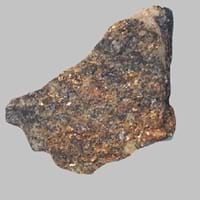Definition
Adakite is an intermediate to felsic volcanic rock that has geochemical characteristics of magma which is said to be formed by partial melting of altered basalt that is subducted below volcanic arcs
During the impact melted material forming a breccia containing glass and crystal or lithic fragments together form Suevite rock.
Origin
Adak, Aleutian Islands
Canada, Germany
Discoverer
Defant and Drummond
Unknown
Etymology
From Adak, Aleutian Islands
No etymologies found
Class
Igneous Rocks
Metamorphic Rocks
Sub-Class
Durable Rock, Medium Hardness Rock
Durable Rock, Medium Hardness Rock
Group
Volcanic
Not Applicable
Other Categories
Fine Grained Rock, Medium Grained Rock, Opaque Rock
Coarse Grained Rock, Opaque Rock
Texture
Porphyritic
Earthy
Color
Black, Brown, Light to Dark Grey
Black, Brown, Colourless, Green, Grey, Pink
Durability
Durable
Durable
Appearance
Dull and Soft
Banded
Interior Uses
Decorative Aggregates, Floor Tiles, Homes, Hotels, Kitchens
Decorative Aggregates, Homes, Interior Decoration
Exterior Uses
As Building Stone, As Facing Stone, Office Buildings
As Building Stone, As Facing Stone, Garden Decoration, Office Buildings
Other Architectural Uses
Whetstones
Curbing
Construction Industry
As Dimension Stone, Cobblestones, Rail Track Ballast, Roadstone
As Dimension Stone, Cement Manufacture, for Road Aggregate, Making natural cement, Manufacture of Magnesium and Dolomite Refractories
Medical Industry
Not Yet Used
Not Applicable
Antiquity Uses
Monuments, Sculpture, Small Figurines
Artifacts, Monuments, Sculpture
Commercial Uses
Commemorative Tablets, Pottery, Used in aquariums
As a Feed Additive for Livestock, Gemstone, Metallurgical Flux, Source of Magnesia (MgO)
Types
Not Available
Phyllosilicates, Calcite
Features
Has High structural resistance against erosion and climate, Host rock for Diamond, Very fine grained rock
Host Rock for Lead
Archaeological Significance
Famous Monuments
Data Not Available
Data Not Available
Famous Sculptures
Data Not Available
Data Not Available
Formation
Adakite rocks are formed when the hydrous fluids are released from minerals that break down in metamorphosed basalt, and rise into the mantle they initiate partial melting.
Suevite is a metamorphic rock consisting partly of melted material, typically forming a breccia containing glass and crystal or lithic fragments, formed during an impact event.
Mineral Content
Olivine, Plagioclase, Pyroxene
Coesite, Quartz, Stishovite
Compound Content
Aluminium Oxide, MgO, Silicon Dioxide
CaO, Carbon Dioxide, MgO
Types of Metamorphism
Cataclastic Metamorphism, Contact Metamorphism, Impact Metamorphism, Regional Metamorphism
Burial Metamorphism, Cataclastic Metamorphism, Contact Metamorphism, Hydrothermal Metamorphism, Impact Metamorphism, Regional Metamorphism
Types of Weathering
Chemical Weathering, Mechanical Weathering
Not Applicable
Types of Erosion
Coastal Erosion, Sea Erosion, Water Erosion
Not Applicable
Grain Size
Fine to Medium Grained
Coarse Grained
Fracture
Conchoidal
Uneven
Streak
Bluish Black
Light to dark brown
Porosity
Less Porous
Less Porous
Luster
Grainy, Pearly and Vitreous
Earthy
Cleavage
Not Available
Irregular
Toughness
Not Available
Not Available
Specific Gravity
Not Available
2.86
Transparency
Opaque
Opaque
Density
Not Available
2.8-2.9 g/cm3
Specific Heat Capacity
Not Available
Resistance
Heat Resistant, Pressure Resistant, Wear Resistant
Heat Resistant
Deposits in Eastern Continents
Asia
India, Russia
Not Yet Found
Africa
Ethiopia, Somalia, South Africa
Not Yet Found
Europe
Iceland
England, France, Germany, Great Britain, Netherlands, Sweden, Switzerland, United Kingdom
Others
Not Yet Found
Not Yet Found
Deposits in Western Continents
North America
Canada, USA
Not Yet Found
South America
Brazil
Not Yet Found
Deposits in Oceania Continent
Australia
Not Yet Found
Not Yet Found
All about Adakite and Suevite Properties
Know all about Adakite and Suevite properties here. All properties of rocks are important as they define the type of rock and its application. Adakite belongs to Igneous Rocks while Suevite belongs to Metamorphic Rocks.Texture of Adakite is Porphyritic whereas that of Suevite is Earthy. Adakite appears Dull and Soft and Suevite appears Banded. The luster of Adakite is grainy, pearly and vitreous while that of Suevite is earthy. Adakite is available in black, brown, light to dark grey colors whereas Suevite is available in black, brown, colourless, green, grey, pink colors. The commercial uses of Adakite are commemorative tablets, pottery, used in aquariums and that of Suevite are as a feed additive for livestock, gemstone, metallurgical flux, source of magnesia (mgo).










